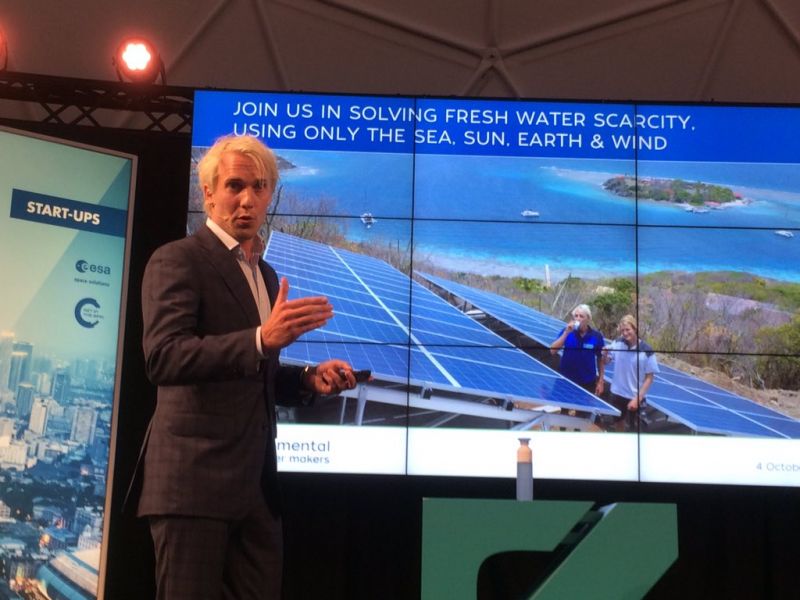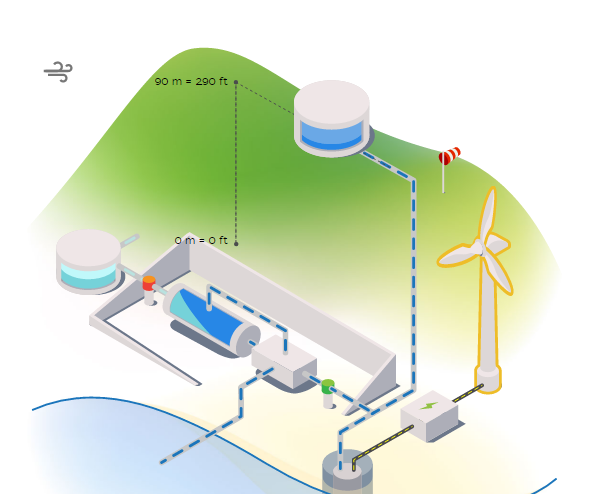In Conversation With: Sid Vollebregt from Elemental Water Makers
Published on by Water Network Research, Official research team of The Water Network in Technology
The Water Network team had the pleasure to interview Sid Vollebregt, Managing Director of Elemental Water Makers.
 Mr. Vollebregt holds a Master degree of the University of Technology in Delft, The Netherlands in Sustainable Energy Technology and Technological Entrepreneurship. He has spent several years abroad and has a passion for innovative international developments in the field of water and renewable energy.
Mr. Vollebregt holds a Master degree of the University of Technology in Delft, The Netherlands in Sustainable Energy Technology and Technological Entrepreneurship. He has spent several years abroad and has a passion for innovative international developments in the field of water and renewable energy.
Mr. Vollebregt is involved in determining the company strategy, commercial developments and project management and has won several pitch awards.
He has a strong vision that desalination driven by renewable energy holds an essential role for the global fresh water supply. He is a water enthusiast full of energy and enjoys spending his free time surfing in the sea, sun and wind.
Elemental Water Makers provides complete reverse osmosis systems driven by solar, wind and/or wave energy to enable affordable fresh water on-site. Our solutions solve fresh water scarcity, while only using the sea, sun, earth & wind.
Q1: Thank you for taking the time to talk to us Sid. Would you please tell us about yourself and your background?
Of course, my pleasure. I’m a water enthusiast aged 30 who is concerned about water scarcity and the negative consequences of fossil fuels. My background is a Master degree of the University of Technology in Delft, The Netherlands in Sustainable Energy Technology & a Bachelor in Mechanical Engineering & Technological Entrepreneurship.
Currently, as the managing director and co-founder of Elemental Water Makers, I’m ensuring fresh water today, without limiting tomorrow. I have a strong vision that desalination driven by renewable energy holds an essential role for the global fresh water supply.
On a more personal note, I feel very connected with water, and the ocean in particular, due to my strong passion for wave and kite-surfing. Therefore I live in close to the beach in Scheveningen and enjoy executing projects on water scarce islands and coastal regions.
 Q2: How do you feel about getting listed as top-100 most inspiring and innovative young professionals in the field of sustainability?
Q2: How do you feel about getting listed as top-100 most inspiring and innovative young professionals in the field of sustainability?
It is a great honor to be listed and this, fortunately, shows that my efforts have not gone by unnoticed. I must add that although receiving this form of recognition is great, the ultimate goal is providing fresh water today, without limiting tomorrow. The impact can only be made by the execution of projects.
Hopefully, this helps in making people aware that it is possible to obtain an affordable fresh water supply through desalination driven by renewable energy.
Q3: How did you get involved in the desalination business and what was the vision behind focusing on renewable energy sources?
I was doing my master Sustainable Energy Technology with my good friend and co-founder Reinoud Feenstra. While searching for an exciting and meaningful graduation project we found the possibility to couple renewable energy with desalination. Desalination currently accounts for almost 1% of the global electricity consumption, while it doesn’t even supply 1% of our global water use.
Realizing the accelerating increase of fresh water scarcity and the negative effects of fossil fuels, we knew what had to be done. This had led us to ensure fresh water today, without limiting tomorrow. Cost savings come first, while at the same time providing guilt-free water.
 Q4: Please tell us about Elemental Water Makers and how the company came to life.
Q4: Please tell us about Elemental Water Makers and how the company came to life.
Being offered the freedom to redesign fluctuating renewable energy to a constant reverse osmosis was an enjoyable challenge during our graduation thesis.
We succeeded in inventing an innovative solution and test our proposed solution during a 6-month field pilot in Indonesia. The success of this project was at the core of founding Elemental Water Makers.
The technology itself is only a small part to create a successful business. We have learned a lot from our customers and all stakeholders involved in the energy and water sector on water scarce islands and coastal regions. By our determination, by lean development and through taking risk we managed to get the company started , have obtained a successful track record and are now scaling up.
Q5: Your desalination idea is driven only by fluctuating renewable energy – would you please elaborate on this?
The problem with renewable energy driven desalination is the coupling of fluctuating renewable sources (sun, wind, waves) with the preferred desalination technology, reverse osmosis, which is designed for constant operation. Existing solutions either use batteries or operate discontinuously, resulting in high cost, limited scalability and variable water quality. Elemental Water Makers solves this problem.
%20and%20Reinoud%20Feenstra,%20founders%20of%20Elemental%20Water%20Makers.jpg) The system uses the renewable energy, for example, solar energy generated by solar panels, which are connected to a seawater pump which displaces the seawater towards an elevated water buffer.
The system uses the renewable energy, for example, solar energy generated by solar panels, which are connected to a seawater pump which displaces the seawater towards an elevated water buffer.
This buffer delivers the required pressure for the reverse osmosis process. The elevation difference required is reduced by 80% using a mechanical form of energy recovery, re-using the excess pressure still present in the brine flow.
For seawater, 90 m or 290 ft is required.
Brackish water requires about half the elevation. The elevated water buffer is filled throughout the day and will be able to cover the nights, producing fresh water without any auxiliary power, leading to affordable fresh water.
The working principle is shown in detail here.
An animated 4-minute movie which introduces and explains the system can be enjoyed here.
Q6: You use pressurized water for reverse osmosis. Please tell us about this in a bit more detail.
Reverse osmosis is a pressure driven process. Normally this pressure is created using (fossil energy driven) high-pressure pumps. Our process still uses pressure, but in this case, this pressure is generated and kept very stable using the power of gravity.
As explained previously the required inlet pressure is reduced by 80% using a mechanical form of energy recovery, allowing for a much larger implementation potential. It’s simple, low on maintenance and very efficient, leading to cheaper water.
Q7: Brine, as a desalination leftover, is a big environmental issue. How do you manage brine?
Brine can indeed be a big environmental issue, which is mostly caused by the large difference in salt concentration between the brine itself and the environment (often sea) it is disposed in. In order for our system to allow for an 80% decrease in required elevation, the system is forced to run at a low recovery ratio, resulting in more energy to be recovered from the brine and thus a lower required elevation.
At the same time, this 80% decrease is only possible when using a very efficient (>95%) energy recovery process. If we add this together, we get a system, which runs at a low recovery ratio, leading to only a slightly more saline (< 20%) brine discharge, while still being able to run a very efficient desalination process.
In short, Elemental Water Makers is able to manage the environmental impact of the brine by keeping the salinity difference with the source water to a minimal. Dilution of the brine is therefore much faster and easier accomplished.
 Q8: Your system needs impressively minimal maintenance due to automation. How did you achieve the automation of everything?
Q8: Your system needs impressively minimal maintenance due to automation. How did you achieve the automation of everything?
The beauty of gravity is that it is a very constant and reliable force. This means that as long as the elevation difference is constant (which is the case with a buffer at a fixed location) the pressure at the reverse osmosis inlet will also be constant.
Add to this a constant salinity of the source water and your desalination process will also be very stable and requires no control apart from process control measurements and a single automated inlet valve to stop the system whenever required.
The renewable energy side of the system is also self-regulating, as it will automatically pump depending on the amount if renewable energy available.
Add only a few basic control inputs, such as buffer overflow protection and pump dry-run protection, and you have a self-regulating source water input system.
Combining the two results in a self-regulating system, in which the direction of flow is automatically determined by gravity. Together with an automated media filter backwash sequence, remote monitoring including text message alarms and very limited use of consumables, we were indeed able to achieve automation and minimal maintenance of nearly everything.
Q9: What is your energy footprint?
The energy we use is comparable to all reverse osmosis solutions, which is a few kWh’s per m³. We are able to already run at 3 kWh/m³ for small scale (5-100 m³/day) water production. As we use only renewable energy and no auxiliary sources, we consider our solutions not to have an energy footprint.
Q10: Considering the rather high cost, compared to other water treatment methods, how important is desalination?
Unfortunately, the situation is such that we, through the food we eat, the products we buy and the energy we consume, currently use 3.5 times more water than the earth provides. As a result, our rivers, lakes and aquifers are drying up. More than half the world’s wetlands have already disappeared. In less than 10 years from now, two-thirds of our world’s population will face water shortages.
Add a growing population and the change of weather patterns by climate change and it’s not hard to imagine that water is becoming a reason for conflict.
The good news is the Earth is mostly covered with water. The bad news is that only 3% is fresh water, the rest are our saline seas. Just a fraction of the fresh water is easily accessible; the remainder is stored in ice caps, glaciers or deep underground. Therefore desalination of seawater will be very important and is the obvious solution to get access to more water.
However, desalination is an energy & fossil fuel intensive industry. Desalination already accounts for 1% of the global electricity consumption, while it currently only supplies half a percentage of our global water needs. This means that desalination powered by renewable energy is basically the only way forward in order to truly provide a sustainable source of freshwater.
Q11: Are there any new technologies you are exploring?
We have developed desalination driven by renewable energy solutions for places that lack elevation.
At the same time, we work closely with our Original Equipment Manufacturers to incorporate new developments in their products.
Q12: What do you think is the future of desalination? How will it change in the following years?
The desalination sector will continue to grow. The sector has to cope with local rules, regulations and subsidies on energy and water, that vary in each municipality.
Giving away free water & energy has become a burden for many countries. Desalination is an unwelcome necessity, especially compared to the free water that many industries have been relying on for too long. The price of water, reliability, quality, service and environmental impact will resume being the main decision criteria.
We believe that desalination driven by renewable energy will become mainstream by producing water at lower rates in the near future.
At the same time, we think that the demand for the decentralized smaller-scale solutions that govern independence and avoid long pipelines will also grow in numbers. We hope that more companies will start taking responsibility for their water footprint.
Q13: What are your future plans for Elemental Water Makers?
We are scaling up to municipal sized projects and are executing our first DBOOT Water Purchase Agreements. This will demonstrate our potential to municipalities, who can start saving on cost without having to invest. We will strive to play an important role in the transition to ‘renewable water’.
We want to make impact and will therefore scale-up in size of our solutions. At the same time, we hope to create more awareness on the subject of water scarcity. It is our ambition to enable an affordable and reliable fresh water supply for all 57 Small Island Developing States, without emitting carbon dioxide.
Q14: Finally, do you have any piece of advice for our readers who work with desalination?
Please consider using renewable energy for your projects, as you most likely will be surprised to the cost savings it can introduce. It’s our duty to understand and take care of the surroundings. Don’t forget to connect with the water you are working on; take a swim or paddle out!
Thank you for your time Sid!
Read More Interviews from the 'In Conversation With' Series
by The Water Network
Attached link
http://www.youtube.com/embed/B4irlTMk_OsMedia
Taxonomy
- Water Footprint
- Water Access
- Technology
- Freshwater
- Desalination
- Reverse Osmosis
- Sustainable Desalination
- Sustainability
- Renewable Energy
- Desalination
- Green Technology
- Carbon Footprint